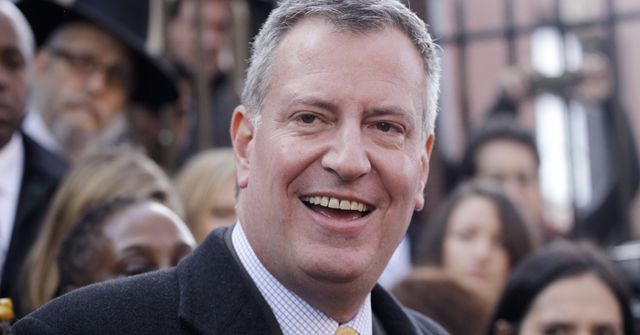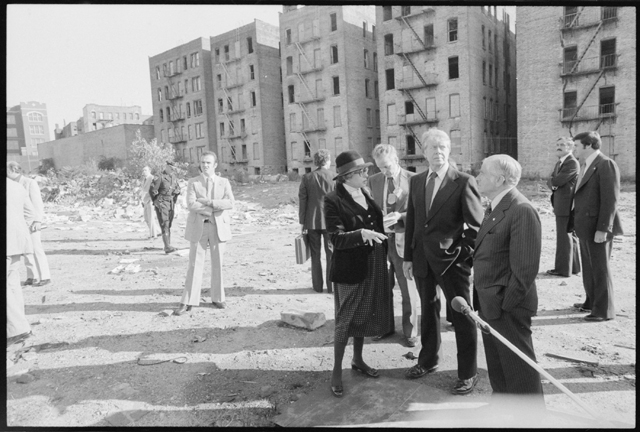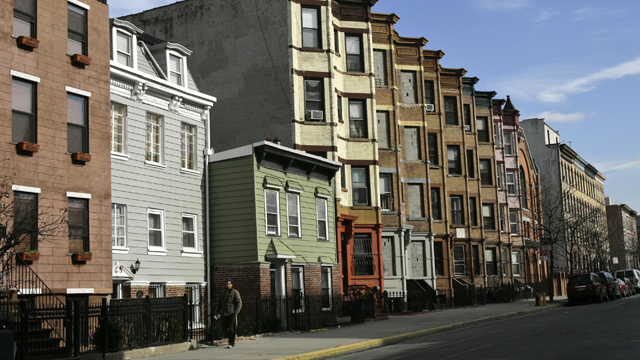
Yesterday, New Yorkers went to the polls and elected the city’s first Democratic mayor in two decades, a self-described progressive who campaigned unabashedly against the city’s stark and growing inequalities. The race brought to the fore a particular narrative of New York City, where Moyers & Company is produced: After 12 years of Michael Bloomberg, the city is more stable than it’s been in decades, but it’s also more divided. An influx of newcomers is driving the city’s growing prosperity, but also fueling its phenomenal inequality.
Bloomberg helmed the city during a time of transformation. New York’s darkest days — the crime waves, arson and near-bankruptcy of the ’70s and early ’80s — are now firmly in the past, a memory invoked only by de Blasio’s detractors to illustrate the perceived harm that a break from Bloomberg orthodoxy could bring about.
But one side effect of New York’s transformation is its growing economic inequality, a gap more dramatic than seen in other American cities. Earlier this year, the average rent in NYC topped $3,000. During Bloomberg’s mayoralty, homelessness increased by 73 percent. Parts of Queens, Brooklyn and upper Manhattan have undergone dramatic demographic shifts as rents have skyrocketed. The rising cost of an apartment in New York’s more far-flung neighborhoods is a handy bellweather for the city’s transformation, and an examination of the diversity of the places New Yorkers call “home” is one of the clearer windows into the trend toward inequality.
Earlier this year, one condo developer drew a lot of attention when it decided to plan a riverfront building with two separate doors — one for the wealthy, one for the less so. The building’s 55 units of affordable housing, for which the developer got tax breaks, would be spread over five floors and would face away from the river and have their own door, elevator and maintenance company, while 219 market rate units would overlook the Hudson.
The idea behind mixed-use housing incentives is, obviously, not to sequester the poor within a structure, but this over-the-top anecdote is a great metaphor for how housing illustrates the disconnect between the rich and the poor. As de Blasio himself noted over and over during his campaign, the 21st century story of New York is a “tale of two cities.”
Will the new mayor make a difference?
Maybe. De Blasio has a host of progressive housing policies he has promised to implement. But he is also working against decades of trends driving inequality, both in New York and nationwide. And one of the biggest forces redefining the city has little to do with any one person or policy: People simply want to live here, and, when it comes to holding one’s ground in this shifting, growing city, New York’s poorer residents are at a disadvantage.
Changing demographics
Between 1960 and 1980, the city’s population decreased by about a million people. Neighborhoods that were once prosperous became poorer as the wealthiest fled for the suburbs. In the most blighted areas, crime was rampant and neighborhoods gradually became deserted. Landlords sometimes set their buildings on fire, hoping the insurance money would help them recoup some of the money they had invested in now-empty homes.
“In the 1970s and 1980s, you could stand on some corners in the South Bronx or the West Bronx, turn around, and not see an occupied multifamily building. [You could] see for blocks and blocks buildings that had been abandoned,” Harold Shultz, a lawyer and long-time housing advocate who worked in New York during the 1970s, recalled to me a few years ago.

HUD Secretary Patricia Harris, President Jimmy Carter and New York Mayor Abraham Beame tour the South Bronx, October 1977. (National Archives)
In 1977, the president came to take a look at the situation. “It was a very sobering trip for me to see the devastation that has taken place in the South Bronx in the last five years,” Jimmy Carter said after surveying the blight.
New York teetered on the edge of bankruptcy in the late ’70s, but gradually began to turn around. The city’s recovery was partially enabled by a series of (at the time) progressive urban policies, but also by an influx of newcomers — many of them immigrants. During the ’90s, the population grew and by 2000, it had passed its previous mid-century peak. And today, New York’s growth appears to be, if anything, gaining momentum.
This growth causes problems. For example, there are more people commuting to work than ever before, but the city has the same number of roads and the same number of subway tunnels. It can buy more trains, but for safety reasons, they can’t run too close to one another. The city is building a new train line parallel to a particularly congested one on Manhattan’s east side, but that project has been in the works for nearly a century.
And just as there is less elbow room available in the subways, there is less housing to go around. Many of the neighborhoods that declined so dramatically 30 years ago are now some of the most desirable — Manhattan’s Lower East Side, for example, and Brooklyn’s Park Slope. Other neighborhoods that had, for decades, been stable lower-income communities are seeing land values and rents increase very quickly as newcomers seek apartments further and further from downtown.
“It’s a process, and neighborhoods are somewhere along the line of that process,” says Erika Poethig, the director of urban policy initiatives at the Urban Institute, and a former acting assistant secretary for the US Department of Housing and Urban Development. “You can see it accelerated in sharper relief in communities like a New York, for instance. But probably in every city across the country, you have some neighborhoods where this gentrification process is underway and putting pressure on rents and housing prices and potentially being managed in some way by the city.”
The elusive mixed-income neighborhood
De Blasio’s policies rely heavily on promoting mixed-income neighborhoods over the starkly homogenous ones emerging across the city.
“One of the important reasons why people are focused on bringing back or trying to facilitate more stable mixed-income communities is because it can improve the quality of services for all people, but especially those of lower incomes,” says Poethig. When higher-income people move into lower-income neighborhoods, they bring a larger tax base and a wider array of services. New businesses move in and bolster the economy. In some cases, higher-income people might bring with them their higher-income expectations, and agitate for better public schools, or more community parks. “Communities of mixed income allow folks to form the kind of networks that promote more income mobility,” says Poethig.
But higher-income people can also, obviously, pay more rent, a fact that landlords and developers can’t be expected to ignore. In his 2006 book There Goes the ‘Hood, Columbia University professor Lance Freeman found that lower-income residents want to stay in their neighborhoods after the neighborhoods gentrify, but often can’t afford to. In an NPR interview, Freeman recalled a conversation he had with one Harlem resident while he was researching the book: There are more supermarkets, the man told him, so it’s easier to access fresh produce. “But then,” recalled Freeman, “another thing he said that I thought was very telling: ‘You know, what good is a nice neighborhood if you can’t afford to live there?’”

A man walks down a residential street in Brooklyn's Park Slope. (AP Photo/Kathy Willens)
Other cities have had some success maintaining mixed-income neighborhoods. Poethig points to Chicago’s land trust as one successful model. The land trust has its origins in the ’80s, when Chicago, like New York, was struggling. As buildings became vacant or fell into foreclosure, the city acquired the land and put it into a nonprofit trust. As neighborhoods improved again, the trust sold the buildings on top of the land, but not the land itself. This allowed residents to own their homes — an important asset — while paying to lease the land from the city. And because the city owns the land, it is shielded against price fluctuations and real estate speculation. Chicago also has a “preservation compact” — an organization that brings together government officials, advocates, nonprofit groups and the private sector to raise funding for affordable housing preservation.
Poethig also highlights Montgomery County, Maryland — the region north of DC and southwest of Baltimore that contains cities including Silver Spring, Bethesda and Rockville. In the 1970s, the county was the first in the country to implement inclusionary zoning, which rewards developers for including a certain percentage of affordable housing in new buildings. In Montgomery County, the developers are allowed to build at a higher density; because of the higher density, they can fit more units into a building, minimizing the loss in profit from the affordable housing units. “We have some nice results [there],” says Poethig, “especially the educational outcome for those kids that have lived in those contexts.”
Following Montgomery County’s model, many other cities have implemented inclusionary zoning. New York is one of them, but incentives for developers have not been enough to maintain the character of many city neighborhoods. And then there was the condominium developer’s two-door solution — certain members of the private sector will always try to game the system.
De Blasio’s solution is to make inclusionary zoning mandatory, a plan he claims would create 50,000 new affordable homes over the next decade.
But will that go far enough?
De Blasio has other policy suggestions that will come into play here as well. He hopes to give New Yorkers facing eviction greater access to legal representation and to make section 8 vouchers available to homeless families living in shelters. He plans to discontinue some corporate tax giveaways, to make more loans available to local entrepreneurs, to raise $530 million from taxing the rich to establish universal preschool and to create after-school programs for middle schoolers. All if these programs, if realized, will help buoy low-income New Yorkers.
But the city is projected to welcome several hundred thousand new residents over the next 30 years, and with vacancy rates already at extremely low levels, the poor will almost inevitably continue to be displaced, perpetuating New York’s march toward becoming a city for the privileged. It remains to be seen if de Blasio’s policies can temper that trend.


